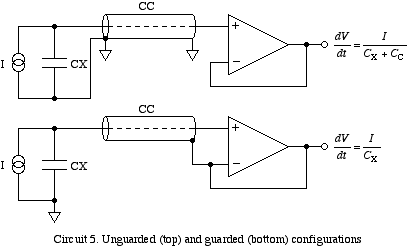Resistive Temperature Detectors
Resistance Temperature Detectors (RTD) exploit the fact that the electrical resistivity of metals and alloys varies in a reproducible way with temperature. Platinum, with a temperature coefficient of about 0.0039 K-1, is the most popular material used in this application. An RTD consists of a coil of wire, or a thin-film, with four-wire electrical connections supported in a way that is a compromise between robustness and thermal time-constant. RTD's have excellent accuracy (e.g. 0.025 K at room temperature) over a wide temperature range. At cryogenic temperatures the resistance of metals becomes constant, and it is usual to use a sample of doped-semiconductor as the sensing element. When using RTDs, it is always important to check that the measured resistance is independent of excitation current in order to avoid errors caused by self-heating.
Strain Gauges
At constant temperature, the resistance R of a metal or semiconductor element of area A, length l, resistivity ρ, is

and when the element is strained this changes by an amount

A typical strain gauge consists of a metal foil, photo-etched to form a serpentine pattern, and mounted on a resin backing film. This is then attached to the structure to be monitored with adhesive. Metal sensor-elements are dominated by the geometric terms in the above equation and therefore they are relatively temperature independent and have a modest gauge factor (i.e. responsivity) of about 2. Semiconductor elements can exploit a large piezo-resistive effect yielding gauge factors of ca 150. However, this is at the expense of temperature stability and some sort of compensation scheme is usually required in practice.
Strain gauges are widely used in many applications; they are small, cheap, sensitive and reliable, and many variables (e.g. pressure) can be be used to cause strain.
Capacitance
Capacitance can also be measured over a wide range at moderate cost. A simple hand-held meter, and some digital multimeters use a two-wire technique to measure capacitances in the range 100 pF to 1 F with an accuracy of about 1%. Such meters often work by incorporating the unknown capacitor into a relaxation oscillator such as the ramp generator experiment in PHY2003. This charges the unknown capacitance with a known constant current, and the capacitance is calculated from the charging time required for it to reach the threshold voltage.
Stray capacitance, typically in the range 10 pF to 10 nF, is the major source of error in capacitance measurements, and must be dealt with using 'guarding' techniques. A high impedance terminal is guarded by ensuring that it is surrounded by conductors held at the same potential by some means. Circuit 5 shows how the influence of the stray capacitance to ground associated with a piece of coaxial cable can be eliminated by reconnecting its shield to a low impedance node.

With care (and about 10,000 dollars worth of equipment) it is possible to measure absolute capacitance values to 1 part in 108 using so-called 'AC coaxial bridges'.
Capacitive sensors are the most precise of all electrical sensors. A capacitive sensor can be designed to be:
- non-dissipative and therefore free of thermal noise
- free from self-heating,
- linear with applied voltage,
- temperature independent.
Simple but very precise sensors can be based on the change in geometry of a pair of capacitor plates, or on the effects of introducing conducting material into the capacitor gap.
Capacitive Pressure Sensors
Capacitive pressure sensors use a thin diaphragm, usually metal or metal-coated quartz, as one plate of a capacitor. The diaphragm is exposed to the process pressure on one side and to a reference pressure on the other. Changes in pressure cause it to deflect and change the capacitance. The change may or may not be linear with pressure and is typically a few percent of the total capacitance. The capacitance can be monitored by using it to control the frequency of an oscillator or to vary the coupling of an AC signal. It is good practice to keep the signal-conditioning electronics close to the sensor in order to mitigate the adverse effects of stray capacitance. Circuit 6 is a schematic example.

Devlopments in silicon-based micro-machine technology have lead to several significant improvements in the performance and usability of capacitve pressure sensors.
No comments:
Post a Comment